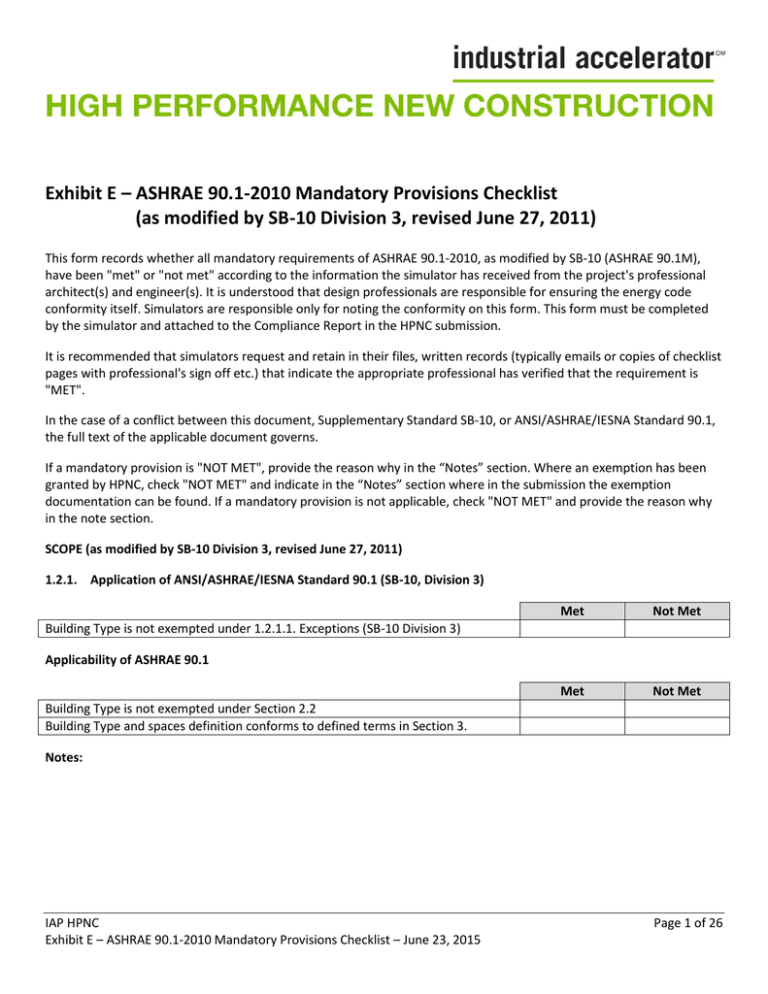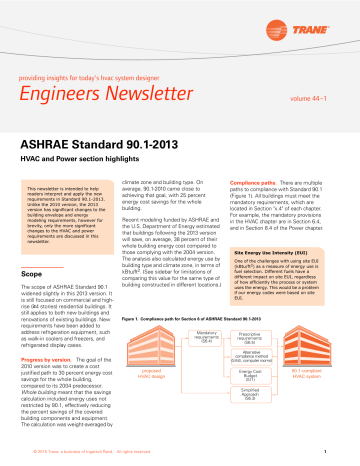

Minimum mechanical equipment efficiencies have been mandatory since the first edition of Standard 90 was published in 1975. Not including a mandatory requirement causes the entire project to be noncompliant.

The entire project team needs to review the mandatory requirements to ensure every discipline includes them in their design. Mandatory requirements are exactly what the term implies: There is no alternate path around them. For example, the energy model could be used to show how glass with a lower solar-heat-gain coefficient (SHGC) reduces peak cooling loads. That effort typically involves collaboration between the architect and engineer on an integrated design and can result in a much higher quality end product. The performance path is more flexible in that nearly any component’s performance can be traded off for something else, but it requires energy modeling-and more effort on the part of the design team. The prescriptive path is a straightforward recipe for compliance but is restrictive in that all items must be met.

Both paths require that all mandatory requirements be met. Standard 90.1-2013 has two paths to compliance: the prescriptive path and the performance path. Perform compliance calculations and documentation.Here are five steps to move a project to compliance with ASHRAE 90.1-2013: The 2015 IECC requires the design energy cost to be less than or equal to 85% of the standard reference design (baseline) rather than just being less than or equal to as in ASHRAE 90.1-2013. If a project can incorporate the more stringent mandatory requirements of ASHRAE 90.1-2013, then a project can take advantage of the lack of additional efficiency packages in the prescriptive path or the lower compliance threshold in the performance path. Requirements between the two standards cannot by mixed and matched.ĪSHRAE 90.1-2013 should be considered more often as a path to compliance. For instance, automatic receptacle controls have been a mandatory requirement for certain space types because ASHRAE 90.1-2010, but they still haven’t appeared as a requirement in any of the currently published versions of the IECC.įor this reason, design teams should weigh which would be the most appropriate standard on a project-by-project basis. They even have different mandatory requirements. They have some requirements that are very similar, such as prescriptive window-to-wall ratio (WWR) limits, and others that are different, like the prescriptive "additional efficiency" packages. Generally, ASHRAE 90.1-2013 is seen as more stringent than the 2015 IECC (see Figure 2). If the 2015 IECC has been adopted, either standard may be used for compliance (unless a local amendment doesn’t allow it). The 2015 IECC and ASHRAE 90.1-2013 are considered to be parallel standards because Standard 90.1-2013 is an alternate compliance path. Green Building Council‘s LEED program, and as an alternate compliance path to the parallel edition of the IECC.
#Ashrae 90.1 user manual code
A few jurisdictions do adopt Standard 90.1 as their energy code, but the application of 90.1 to projects is largely through above code programs, such as U.S. Most jurisdictions adopt a version of the International Energy Conservation Code (IECC), which is often viewed as a codified version of ASHRAE Standard 90.1 even though they are developed independently.


 0 kommentar(er)
0 kommentar(er)
